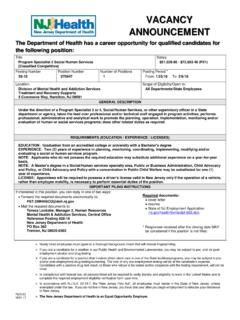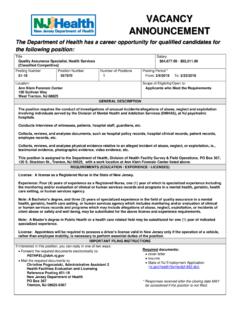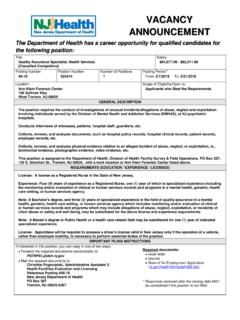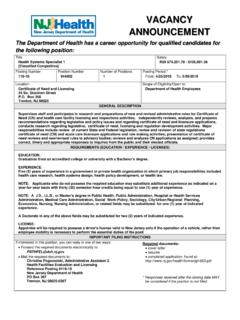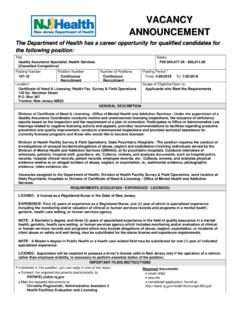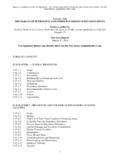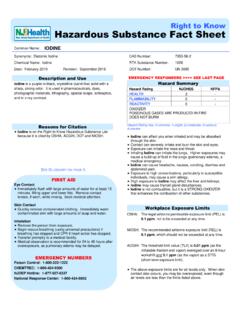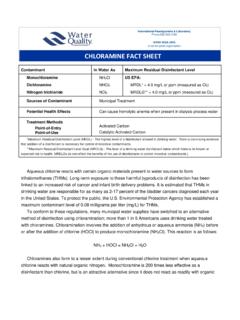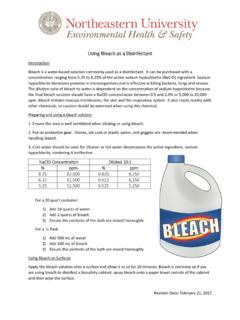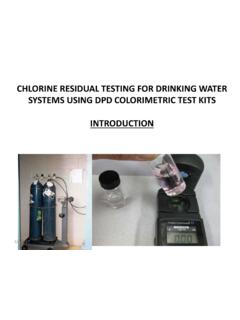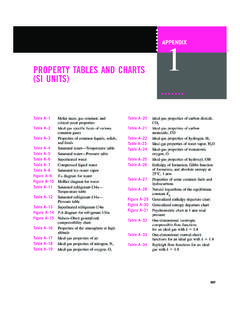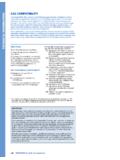Transcription of MUSTARD GAS HAZARD SUMMARY Mustard Gas
1 Common Name: MUSTARD GAS CAS Number: 505-60-2 DOT Number: UN 2810 DOT HAZARD Class: (Toxic Liquid) ---------------------------------------- --------------------------------- HAZARD SUMMARY * MUSTARD Gas can affect you when breathed in and by passing through your skin. * MUSTARD Gas is a CARCINOGEN--HANDLE WITH EXTREME CAUTION. * MUSTARD Gas is an EXTREMELY DANGEROUS POISON GAS and contact with the liquid or exposure to high vapor concentrations can cause severe eye burns and permanent eye damage. * MUSTARD Gas can cause severe skin burns and blisters. * Breathing MUSTARD Gas can irritate the lungs causing coughing and/or shortness of breath. Higher exposures can cause a build-up of fluid in the lungs (pulmonary edema), a medical emergency, with severe shortness of breath. * MUSTARD Gas can cause chronic bronchitis to develop. IDENTIFICATION MUSTARD Gas, when pure, is a colorless and odorless oily liquid.
2 Warfare Agent grade MUSTARD Gas is yellow to dark brown. The odor may be like burning garlic, horseradish, or sweet and agreeable. It is used as a chemical warfare agent and in organic synthesis. REASON FOR CITATION * MUSTARD Gas is on the Hazardous Substance List because it is cited by NTP, DEP, IARC and EPA. * This chemical is on the Special Health HAZARD Substance List because it is a CARCINOGEN and MUTAGEN. * Definitions are provided on page 5. HOW TO DETERMINE IF YOU ARE BEING EXPOSED The New Jersey Right to Know Act requires most employers to label chemicals in the workplace and requires public employers to provide their employees with information and training concerning chemical hazards and controls. The federal OSHA HAZARD Communication Standard (29 CFR ) requires private employers to provide similar training and information to their employees.
3 RTK Substance number: 1319 Date: June 1998 Revision: March 2006 ---------------------------------------- --------------------------------- * Exposure to hazardous substances should be routinely evaluated. This may include collecting personal and area air samples. You can obtain copies of sampling results from your employer. You have a legal right to this information under the OSHA Access to Employee Exposure and Medical Records Standard (29 CFR ). * If you think you are experiencing any work-related health problems, see a doctor trained to recognize occupational diseases. Take this Fact Sheet with you. WORKPLACE EXPOSURE LIMITS No occupational exposure limits have been established for MUSTARD Gas by OSHA, NIOSH or ACGIH. However, the National Advisory Committee for the Agency for Toxic Substances and Disease Registry (ATSDR) has recommended acute exposure guidelines (AEGLs) to protect people from the harmful effects of MUSTARD Gas.
4 The AEGL 1 guidelines are mg/m3 ( ppm) for a 10-minute exposure to mg/m3 ( ppm) for an 8-hour exposure. * MUSTARD Gas is a CARCINOGEN in humans. There may be no safe level of exposure to a carcinogen, so all contact should be reduced to the lowest possible level. * The above exposure limits are for air levels only. When skin contact also occurs, you may be overexposed, even though air levels are less than the limit listed above. WAYS OF REDUCING EXPOSURE * Enclose operations and use local exhaust ventilation at the site of chemical release. If local exhaust ventilation or enclosure is not used, respirators must be worn. * A regulated, marked area should be established where MUSTARD Gas is handled, used, or stored. * Wear protective work clothing. * Wash thoroughly immediately after exposure to MUSTARD Gas and at the end of the workshift. * Post HAZARD and warning information in the work area.
5 In addition, as part of an ongoing education and training effort, communicate all information on the health and safety hazards of MUSTARD Gas to potentially exposed workers. MUSTARD GAS page 2 of 6 This Fact Sheet is a SUMMARY source of information of all potential and most severe health hazards that may result from exposure. Duration of exposure, concentration of the substance and other factors will affect your susceptibility to any of the potential effects described below. ---------------------------------------- ---------------------------------- HEALTH HAZARD INFORMATION Acute Health Effects The following acute (short-term) health effects may occur immediately or shortly after exposure to MUSTARD Gas: * Contact with the liquid or exposure to high vapor concentrations can cause severe eye burns and permanent eye damage. There is no pain on contact, but hours later redness, swelling and pain occur.
6 Blindness can result. * MUSTARD Gas can cause severe skin burns and blisters. * Breathing MUSTARD Gas can irritate the lungs causing coughing and/or shortness of breath. Higher exposures can cause a build-up of fluid in the lungs (pulmonary edema), a medical emergency, with severe shortness of breath. Chronic Health Effects The following chronic (long-term) health effects can occur at some time after exposure to MUSTARD Gas and can last for months or years: Cancer HAZARD * MUSTARD Gas is a CARCINOGEN in humans. It has been shown to cause lung, tongue, throat and voice box cancer. Reproductive HAZARD * There is limited evidence that MUSTARD Gas may damage the male reproductive system including decreasing the sperm count and affecting male fertility. Other Long-Term Effects * MUSTARD Gas can cause chronic bronchitis to develop with cough, phlegm and/or shortness of breath. MEDICAL Medical Testing If symptoms develop or overexposure is suspected, the following are recommended: * Lung function tests * Exam of the eyes, including slit-lamp * Consider chest x-ray after acute overexposure Any evaluation should include a careful history of past and present symptoms with an exam.
7 Medical tests that look for damage already done are not a substitute for controlling exposure. Request copies of your medical testing. You have a legal right to this information under the OSHA Access to Employee Exposure and Medical Records Standard (29 CFR ). Mixed Exposures * Because smoking can cause heart disease, as well as lung cancer, emphysema, and other respiratory problems, it may worsen respiratory conditions caused by chemical exposure. Even if you have smoked for a long time, stopping now will reduce your risk of developing health problems. WORKPLACE CONTROLS AND PRACTICES Unless a less toxic chemical can be substituted for a hazardous substance, ENGINEERING CONTROLS are the most effective way of reducing exposure. The best protection is to enclose operations and/or provide local exhaust ventilation at the site of chemical release. Isolating operations can also reduce exposure.
8 Using respirators or protective equipment is less effective than the controls mentioned above, but is sometimes necessary. In evaluating the controls present in your workplace, consider: (1) how hazardous the substance is, (2) how much of the substance is released into the workplace and (3) whether harmful skin or eye contact could occur. Special controls should be in place for highly toxic chemicals or when significant skin, eye, or breathing exposures are possible. In addition, the following control is recommended: * Where possible, automatically pump liquid MUSTARD Gas from drums or other storage containers to process containers. Good WORK PRACTICES can help to reduce hazardous exposures. The following work practices are recommended: * Workers whose clothing has been contaminated by MUSTARD Gas should change into clean clothing promptly.
9 * Do not take contaminated work clothes home. Family members could be exposed. * Contaminated work clothes should be laundered by individuals who have been informed of the hazards of exposure to MUSTARD Gas. * Eye wash fountains should be provided in the immediate work area for emergency use. * If there is the possibility of skin exposure, emergency shower facilities should be provided. * On skin contact with MUSTARD Gas, immediately wash or shower to remove the chemical. At the end of the workshift, wash any areas of the body that may have contacted MUSTARD Gas, whether or not known skin contact has occurred. * Do not eat, smoke, or drink where MUSTARD Gas is handled, processed, or stored, since the chemical can be swallowed. Wash hands carefully before eating, drinking, applying cosmetics, smoking, or using the toilet.
10 MUSTARD GAS page 3 of 6 PERSONAL PROTECTIVE EQUIPMENT WORKPLACE CONTROLS ARE BETTER THAN PERSONAL PROTECTIVE EQUIPMENT. However, for some jobs (such as outside work, confined space entry, jobs done only once in a while, or jobs done while workplace controls are being installed), personal protective equipment may be appropriate. The OSHA Personal Protective Equipment Standard (29 CFR ) requires employers to determine the appropriate personal protective equipment for each HAZARD and to train employees on how and when to use protective equipment. The following recommendations are only guidelines and may not apply to every situation. Clothing * Avoid skin contact with MUSTARD Gas. Wear protective gloves and clothing. Safety equipment suppliers/manufacturers can provide recommendations on the most protective glove/clothing material for your operation.

